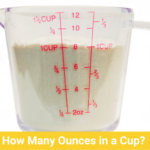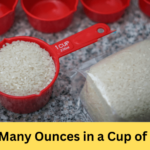Welcome to the Ultimate Guide on measuring coffee in ounces and cups. Whether you’re a coffee connoisseur, a casual drinker, or someone who simply enjoys a comforting cup of joe, understanding the measurement conversions for coffee is essential. As coffee enthusiasts, we know that achieving the perfect brew requires more than just pouring water over grounds. It involves a delicate balance of coffee-to-water ratio, and that’s where knowing the right measurements in ounces and cups becomes crucial.
In this comprehensive guide, we will explore the fascinating world of coffee measurements and answer the burning question, “How many ounces in a cup of coffee?” We’ll delve into different variations, sizes, and capacities to give you a complete understanding of coffee measurements. From deciphering the ounces in a standard cup of coffee to unraveling the mysteries of coffee pot capacities, we’ll leave no stone unturned.
The typical size of a cup of coffee is 8 fluid ounces. However, cup sizes can vary, ranging from 6 to 12 fluid ounces, depending on personal preference and cultural norms. It’s important to consider the specific cup size when measuring and brewing your coffee for the perfect cup every time.
Why is it so important to know the right coffee-to-water ratio? Well, the ratio directly affects the taste, strength, and overall quality of your brew. By mastering the art of measuring coffee in ounces and cups, you’ll be able to achieve that perfect balance that tantalizes your taste buds and elevates your coffee-drinking experience.
So, whether you’re a coffee aficionado seeking precision or a casual coffee lover looking to enhance your brewing skills, this guide is here to enlighten you. Get ready to unlock the secrets of coffee measurements, explore the interplay between ounces and cups, and discover the ideal coffee-to-water ratio for your preferred cup of java. Let’s dive into the world of coffee measurements and unravel the mysteries of how many ounces are in a cup of coffee.
Maybe you concern: How Many Ounces In A Quarter Cup?
Understanding the Basics
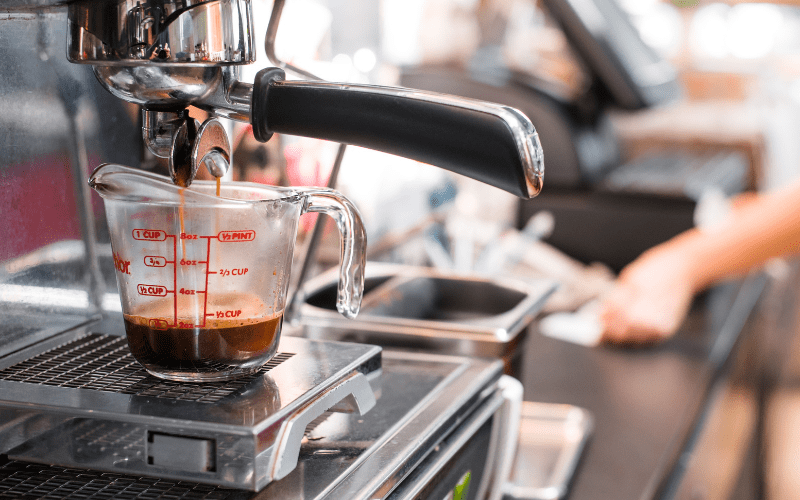
What is a Cup of Coffee?
When we talk about a cup of coffee, we are referring to a standard unit of measurement used to quantify the amount of coffee typically served. However, it’s important to note that the definition of a “cup” can vary depending on different factors such as geographical location, cultural preferences, and even the type of coffee being served.
Defining a Standard Cup of Coffee
In most countries, a standard cup of coffee is generally recognized as 8 fluid ounces (237 milliliters). This measurement is based on the standard U.S. cup size used for culinary and beverage purposes. It provides a baseline for coffee measurements and allows for consistency in brewing techniques and recipes.
Different Variations of Coffee Cup Sizes
Despite the existence of a standard cup size, it’s important to acknowledge that various coffee establishments and regions may have different cup sizes based on their own preferences and traditions. For instance:
- Small Cup: Some cafes or regions may offer smaller cup sizes, typically ranging from 4 to 6 fluid ounces (118 to 177 milliliters). These smaller cups are often used for serving espresso or specialty drinks with concentrated flavors.
- Medium Cup: The medium cup size can vary widely, but it generally falls within the range of 10 to 12 fluid ounces (296 to 355 milliliters). This size is commonly used for regular coffee servings in many cafes and households.
- Large Cup: A large cup of coffee typically ranges from 14 to 16 fluid ounces (414 to 473 milliliters) or even more. This size is popular among those who prefer a larger volume of coffee for extended sipping or for specialty beverages that require additional space for ingredients and toppings.
It’s worth mentioning that these cup sizes are not set in stone and can vary depending on regional preferences, coffee shops, or even personal choices. The variations in cup sizes contribute to the diversity and individuality of the coffee experience, allowing consumers to find their preferred serving size.
Ounces vs. Fluid Ounces
In the realm of coffee measurements, you may come across two similar yet distinct terms: ounces and fluid ounces. Understanding the difference between these two measurements is essential when it comes to accurately measuring and brewing coffee.
Differentiating between Ounces and Fluid Ounces
Ounces, commonly represented as “oz,” is a unit of weight or mass used in various contexts. It is a measurement of the actual physical weight of an object. For example, when you purchase coffee beans, they are often measured in ounces to determine the quantity you are buying.
Fluid ounces, denoted as “fl oz,” on the other hand, measure volume or the amount of space occupied by a liquid. It specifically refers to the volume of a liquid, such as water or brewed coffee.
It’s important to note that fluid ounces measure volume, while ounces measure weight. This distinction is crucial when dealing with coffee, as the amount of coffee required for a particular brewing method is typically determined by volume rather than weight.
Why Fluid Ounces are Commonly Used for Measuring Coffee?
Fluid ounces are commonly used for measuring coffee because coffee is primarily a liquid-based beverage. Brewing coffee involves the extraction of flavor and aroma compounds from coffee grounds using water. To achieve a consistent and balanced brew, it is necessary to measure the amount of water accurately.
Using fluid ounces as a measurement for water and brewed coffee provides a practical and straightforward approach to ensure precise ratios and maintain consistency in the brewing process. By measuring the water in fluid ounces, you can easily match it with the desired coffee-to-water ratio and achieve the desired strength and flavor in your cup of coffee.
Moreover, using fluid ounces allows for easier recipe scaling. Many coffee recipes, including those for specialty drinks or alternative brewing methods, often provide instructions in fluid ounces. This standardization allows coffee enthusiasts to recreate their favorite beverages consistently, whether they are making a single cup or a larger batch.
Understanding the distinction between ounces and fluid ounces is crucial for accurately measuring coffee and water in various brewing methods. By embracing fluid ounces as the preferred unit of measurement for coffee, you can master the art of brewing and achieve that perfect cup every time.
Coffee Measurement Conversions
When it comes to coffee measurements, it’s important to be familiar with the conversion factors between different units. This knowledge enables coffee enthusiasts to seamlessly transition between measurements and ensure consistent brewing results. Let’s explore the conversions between ounces and cups, as well as the relationship between ounces and tablespoons specifically for coffee.
Conversion Factors for Ounces to Cups
- Standard Conversion: In general, there are 8 fluid ounces in a cup. This conversion factor is widely accepted and considered the standard for most recipes and brewing methods. So, if you have a measurement in ounces and want to convert it to cups, divide the number of ounces by 8 to obtain the equivalent value in cups. For example, 16 ounces would be equal to 2 cups.
- Customary and Metric Conversions: It’s worth noting that in the United States customary system, a cup is equivalent to 8 fluid ounces, while in the metric system, a cup is approximately 8.45 fluid ounces (250 milliliters). This slight difference arises due to the conversion between different measurement systems.
- Varied Cup Sizes: Keep in mind that various cup sizes exist, as mentioned earlier, which can affect conversion factors. Adjustments may be necessary if you encounter cups with different volumes.
Read also: How Many Ounces In 2 Cups?
Relationship between Ounces and Tablespoons for Coffee
When it comes to measuring coffee specifically, you may find it helpful to understand the relationship between ounces and tablespoons. This is especially relevant when you need to measure coffee grounds for brewing.
- Coffee-to-Water Ratio: Coffee-to-water ratio is often expressed in tablespoons per cup. As a starting point, a common recommendation is to use one to two tablespoons of coffee grounds for every 6 fluid ounces of water. This ratio can be adjusted based on personal preference and desired strength.
- Ounces to Tablespoons Conversion: The conversion from ounces to tablespoons is not a direct or consistent one, as it can vary depending on the density of the coffee grounds. However, a general guideline is that 1 ounce of coffee grounds is approximately equivalent to 2 tablespoons. This estimation can be used as a starting point for measuring coffee grounds using tablespoons.
Keep in mind that the conversion between ounces and tablespoons for coffee is an estimation and may vary based on factors such as grind size and bean density. It’s always recommended to experiment and adjust the coffee-to-water ratio to achieve the desired taste profile.
How Many Ounces in a Cup of Coffee?
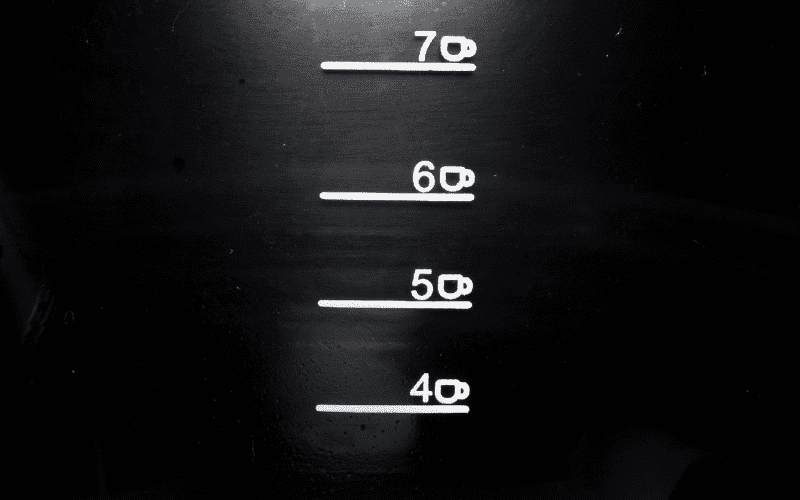
Determining the exact number of ounces in a cup of coffee can be a bit challenging due to variations in cup sizes and personal preferences. However, we can provide some general guidelines to help you understand the typical range of coffee ounces in a standard cup.
Standard Cup of Coffee
A standard cup of coffee is commonly considered to be 8 fluid ounces (237 milliliters). This measurement provides a baseline for coffee servings and is widely used in recipes and brewing instructions. Many coffee makers and brewing equipment are designed to brew a standard cup size of 8 ounces.
It’s important to note that this standard cup size may vary in different countries or regions. For example, in some European countries, a cup of coffee may be closer to 6 fluid ounces (177 milliliters) rather than 8 ounces. Always consider regional variations and the specific coffee culture when determining the size of a standard cup in a particular context.
Coffee Pot and Brewer Capacities
Coffee pots or brewers often indicate their capacity in terms of cups. However, it’s essential to understand that the cup sizes mentioned on coffee pots or brewing equipment may not necessarily match the standard 8-ounce cup. The cup size mentioned on the equipment may be smaller or larger, impacting the overall ounces in a cup of coffee.
To determine the number of ounces in a cup of coffee brewed from your specific equipment, refer to the manufacturer’s instructions or manual. It will typically specify the cup size used for measuring and brewing coffee.
Measuring Coffee-to-Water Ratio
When it comes to brewing coffee, understanding the coffee-to-water ratio is crucial for achieving a well-balanced and flavorful cup. The general recommendation is to use 1 to 2 tablespoons of coffee grounds per 6 fluid ounces (177 milliliters) of water. This ratio can be adjusted based on personal preference and desired strength.
To determine the ounces of coffee needed per cup, you can follow a simple guideline:
- For a mild or lighter brew, use 1 tablespoon of coffee per 6 fluid ounces (177 milliliters).
- For a stronger brew, use 2 tablespoons of coffee per 6 fluid ounces (177 milliliters).
Remember, these guidelines are not set in stone, and you can always adjust the ratio to suit your taste preferences. Experimentation is key to finding your ideal coffee-to-water ratio.
Coffee Bag Sizes and Cup Quantities
Coffee is often sold in bags, and understanding the relationship between bag sizes and the number of cups they can yield is helpful for planning and purchasing the right amount of coffee. Let’s explore how coffee bag sizes relate to cup quantities.
Determining the Number of Cups of Coffee in a 12 oz Bag
A 12 oz bag of coffee typically contains whole coffee beans or pre-ground coffee. The number of cups you can make from a 12 oz bag depends on several factors, including the desired strength of your coffee, the coffee-to-water ratio you prefer, and the size of your cup.
As a general guideline, a 12 oz bag of coffee can produce approximately 24 to 36 cups of coffee. This estimate assumes a standard coffee-to-water ratio of 1 to 2 tablespoons of coffee per 6 fluid ounces (177 milliliters) of water. However, keep in mind that individual preferences may vary, and you can adjust the amount of coffee you use to achieve your desired strength.
Analyzing Coffee Bag Sizes and Their Relation to Cup Quantities
Coffee bag sizes can vary, ranging from small sample sizes to large bulk packages. Here are some common coffee bag sizes and their approximate cup quantities:
- 2 oz Bag: A small 2 oz bag of coffee can yield approximately 4 to 6 cups of coffee, assuming the standard coffee-to-water ratio.
- 8 oz Bag: An 8 oz bag of coffee can typically produce around 16 to 24 cups of coffee, based on the standard ratio.
- 16 oz (1 lb) Bag: A standard 16 oz (1 lb) bag of coffee can yield approximately 32 to 48 cups of coffee, assuming the standard ratio.
It’s important to note that these estimates are approximate and depend on various factors, including personal preference, brewing method, and coffee strength. Additionally, different coffee brands may have variations in density and grind size, which can affect the amount of coffee needed for a cup.
When selecting a coffee bag size, consider your consumption habits, the frequency of brewing, and the freshness of the coffee. It’s often recommended to buy coffee in smaller quantities to ensure maximum freshness, as coffee beans or grounds start to lose their flavor and aroma over time.
Ground Coffee and Brewed Coffee
To understand the difference between ground coffee and brewed coffee, it’s important to distinguish between the measurements of the two. Let’s explore the variance in ounces between ground coffee and brewed coffee, along with the conversion factors involved.
Explaining the Difference between Ground Coffee and Brewed Coffee in Ounces
Ground coffee refers to coffee beans that have been processed and finely ground, ready for brewing. When measuring ground coffee, the weight is typically expressed in ounces. For example, you might find bags of ground coffee labeled as 12 ounces, 16 ounces, or even larger quantities.
Brewed coffee, on the other hand, refers to the final product that results from extracting the flavor and aroma of the coffee beans using water. When measuring brewed coffee, the volume is usually expressed in fluid ounces.
It’s important to note that the weight of ground coffee will differ from the volume of brewed coffee due to various factors such as water absorption, evaporation, and the extraction process.
Conversion Factors between Ground Coffee and Brewed Coffee
While there isn’t a direct conversion between ounces of ground coffee and fluid ounces of brewed coffee, it’s helpful to understand a general guideline for estimating the relationship between the two measurements:
- Approximate Conversion: As a rough estimate, for every ounce (weight) of ground coffee, you can expect to yield approximately 6 fluid ounces (volume) of brewed coffee. This estimation assumes a standard coffee-to-water ratio of 1 to 2 tablespoons of ground coffee per 6 fluid ounces of water.
- Adjusting to Personal Preferences: Keep in mind that the strength and taste preferences for brewed coffee can vary. Some individuals may prefer a stronger brew and use a higher coffee-to-water ratio, resulting in a smaller volume of brewed coffee per ounce of ground coffee. Conversely, others may prefer a milder brew and use a lower coffee-to-water ratio, resulting in a larger volume of brewed coffee per ounce of ground coffee.
It’s important to experiment and adjust the coffee-to-water ratio to achieve the desired strength and flavor in your brewed coffee. Remember, these conversion factors are general guidelines, and personal preferences should ultimately guide your brewing decisions.
Special Considerations and Variations
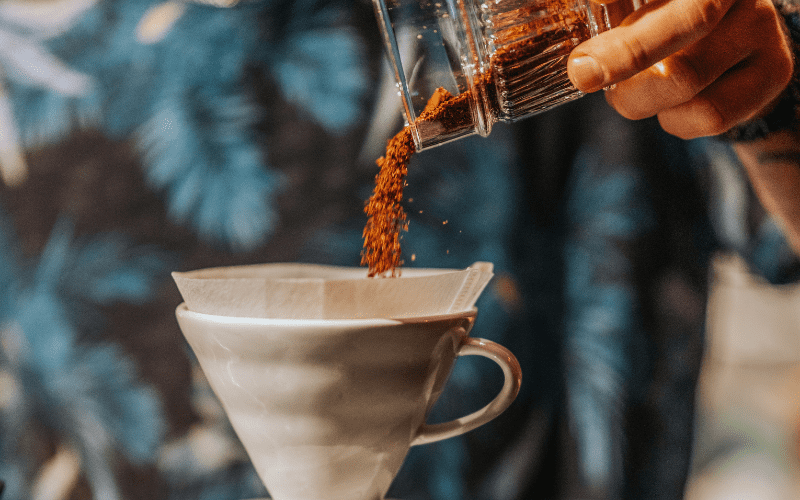
Mug Sizes and Coffee Measurements
Mugs are a popular choice for enjoying a comforting cup of coffee, and understanding their sizes is important for determining the amount of coffee to brew. Let’s delve into the typical size of a mug of coffee in ounces and explore the variations in mug sizes and their impact on coffee measurement.
Determining the Typical Size of a Mug of Coffee in Ounces
The typical size of a mug can vary depending on personal preference, cultural norms, and even the specific design or style of the mug. However, a standard mug for coffee is generally around 8 to 12 fluid ounces (237 to 355 milliliters). This size provides a comfortable capacity for a satisfying cup of coffee.
It’s worth noting that larger mugs can range from 14 to 16 fluid ounces (414 to 473 milliliters) or even more. These larger mugs are often favored by those who prefer a more generous serving size or enjoy specialty coffee drinks with additional ingredients and toppings.
When determining the size of a mug, it’s essential to consider its capacity in fluid ounces rather than solely relying on visual appearance or general descriptors like “small,” “medium,” or “large.”
Exploring the Variations in Mug Sizes and Their Impact on Coffee Measurement
The variations in mug sizes can significantly impact coffee measurement. Larger mugs require more coffee to maintain the desired strength and flavor profile, while smaller mugs necessitate a smaller amount of coffee.
For example, if you typically brew a cup of coffee using a standard 8-ounce cup, you may find that the same amount of coffee in a larger 16-ounce mug results in a weaker brew due to the increased volume of water. Conversely, brewing the same amount of coffee in a smaller 6-ounce mug might yield a stronger brew due to the reduced volume of water.
Different Brewing Methods and Coffee Cup Sizes
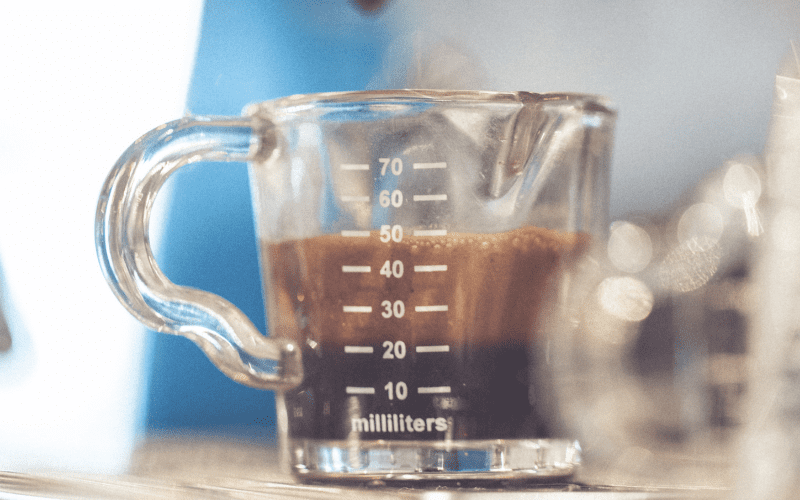
Different brewing methods have their own unique characteristics, including the type of coffee cup sizes they are associated with. Let’s explore how coffee cup sizes can vary across various brewing methods, such as French press, pour-over, and espresso. Additionally, we’ll discuss how cup sizes can impact the brewing process and the resulting flavor of the coffee.
Analyzing Coffee Cup Sizes for Various Brewing Methods
- French Press: French press brewing typically involves a coarser grind and a longer steeping time. The coffee is brewed directly in the French press carafe, and the resulting coffee is usually poured into larger coffee cups or mugs, ranging from 8 to 12 fluid ounces (237 to 355 milliliters). This allows for a generous serving size and the preservation of the coffee’s aroma and heat.
- Pour-Over: Pour-over brewing is known for its precision and control over the extraction process. It often involves using a dripper or a pour-over device placed on top of a coffee cup or carafe. The cup sizes used for pour-over brewing can vary, but they are generally smaller, ranging from 6 to 10 fluid ounces (177 to 296 milliliters). This allows for a more concentrated and nuanced flavor profile.
- Espresso: Espresso brewing involves forcing hot water through finely ground coffee using high pressure. Espresso shots are typically served in small demitasse cups, which have a capacity of about 1 to 2 fluid ounces (30 to 60 milliliters). The small cup size helps to concentrate the intense flavors and aromas of the espresso, creating a rich and powerful shot.
How Cup Sizes Affect the Brewing Process and Coffee Flavor?
The size of the coffee cup used in brewing can influence both the brewing process and the resulting flavor of the coffee:
- Extraction and Brew Time: Larger cup sizes, such as those used in French press brewing, allow for a longer brew time and extended contact between the coffee and water. This can result in a fuller-bodied coffee with a robust flavor profile. Smaller cup sizes, like those used in espresso brewing, facilitate a shorter brew time and quicker extraction, yielding a more concentrated and intense flavor.
- Coffee-to-Water Ratio: Cup sizes also affect the coffee-to-water ratio, which plays a crucial role in flavor extraction. Larger cups may require a higher volume of coffee grounds to maintain a balanced and flavorful brew. Smaller cups, on the other hand, necessitate a lower coffee-to-water ratio to achieve a desired strength.
- Heat Retention and Aroma Preservation: Cup sizes can impact the heat retention and aroma preservation of the coffee. Larger cups provide more surface area for the coffee to cool down, while smaller cups help retain heat for a longer duration. Additionally, smaller cups concentrate the aroma, enhancing the sensory experience.
Commercial Coffee Cups and Specialty Drinks
Commercial coffee cups and specialty coffee drinks have their own unique serving sizes that cater to specific preferences and market demands. Let’s explore the ounces in standard commercial coffee cups and take a closer look at the serving sizes of popular specialty coffee drinks.
Understanding the Ounces in Standard Commercial Coffee Cups
Standard commercial coffee cups found in cafes and coffee shops typically range in size from 8 to 16 fluid ounces (237 to 473 milliliters). These cups are designed to accommodate a single serving of coffee and are often made of materials that offer insulation to keep the beverage hot and maintain its temperature.
It’s worth noting that the specific ounce capacity of commercial coffee cups may vary among establishments. Some coffee shops may offer larger cup sizes, such as 20 or 24 fluid ounces (591 to 710 milliliters), catering to those who prefer a larger quantity of coffee for longer sipping.
Examining Specialty Coffee Drinks and Their Serving Sizes
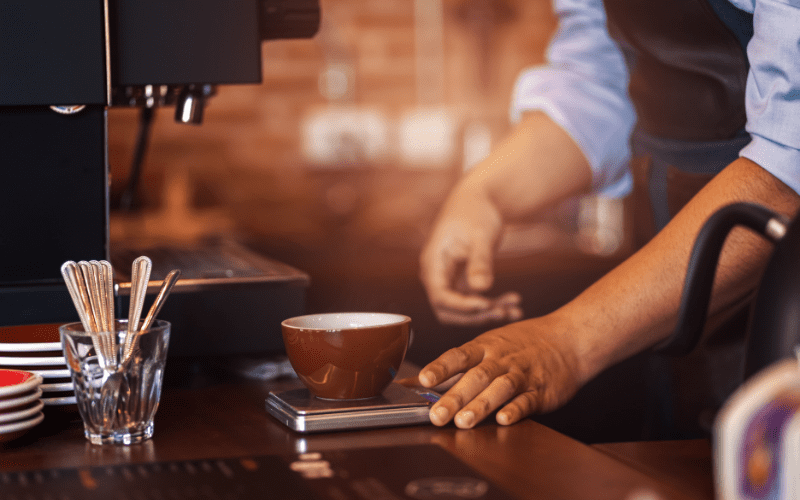
Specialty coffee drinks often feature unique flavor combinations, additional ingredients, and artistic presentations. The serving sizes of these drinks can vary depending on the specific recipe and establishment. Here are some examples:
- Cappuccino: A traditional cappuccino typically consists of equal parts espresso, steamed milk, and milk foam. The serving size of a cappuccino typically ranges from 6 to 8 fluid ounces (177 to 237 milliliters). The smaller size allows the rich espresso flavor to shine, balanced by the creamy milk and foam.
- Latte: Lattes are made with espresso and a larger quantity of steamed milk, often topped with a small amount of milk foam. The serving size of a latte commonly ranges from 8 to 12 fluid ounces (237 to 355 milliliters). The additional milk in a latte provides a smoother and creamier texture.
- Mocha: A mocha combines espresso, steamed milk, chocolate syrup or cocoa powder, and sometimes whipped cream. The serving size of a mocha is similar to that of a latte, typically ranging from 8 to 12 fluid ounces (237 to 355 milliliters). The indulgent addition of chocolate adds a delightful richness to the drink.
- Iced Coffee: Iced coffee is a popular cold beverage made by pouring chilled or brewed coffee over ice. The serving size of an iced coffee often ranges from 12 to 24 fluid ounces (355 to 710 milliliters), offering a refreshing option for those who prefer their coffee chilled.
These serving sizes are general guidelines, and actual measurements may vary based on the establishment and the preferences of the customer. Specialty coffee shops often provide their own unique twist on serving sizes and may offer a wider range of options to cater to individual tastes.
FAQs

How many ounces are in a pound of coffee?
There are 16 ounces in a pound of coffee. This conversion applies to both whole coffee beans and pre-ground coffee.
How much coffee do I need for a 12 oz cup?
As a general guideline, you can use approximately 1 to 2 tablespoons of coffee grounds for a 12 oz cup. Adjust the amount based on your preferred strength.
How many ounces are in a large cup of coffee?
The size of a large cup of coffee can vary, but it typically ranges from 14 to 20 fluid ounces (414 to 591 milliliters). The specific size may depend on the establishment or personal preferences.
How many ounces are in a cup of coffee made in a coffee maker?
A cup of coffee made in a coffee maker usually refers to a standard 8-ounce cup. However, it’s important to check the manufacturer’s instructions as the cup sizes mentioned on coffee makers may vary.
How many ounces of coffee grounds are needed for a cup of coffee?
A standard guideline is to use 1 to 2 tablespoons of coffee grounds per 6 fluid ounces (177 milliliters) of water. Adjust the amount based on your desired strength and personal taste.
How many ounces are in a serving of coffee?
A serving of coffee typically refers to a standard cup size, which is 8 fluid ounces (237 milliliters). However, serving sizes may vary depending on personal preferences and cultural norms.
How many ounces are in a Keurig cup of coffee?
A Keurig cup, also known as a K-Cup, usually brews a single serving of coffee, which is approximately 6 to 8 fluid ounces (177 to 237 milliliters). Some Keurig machines offer the option to brew larger cup sizes as well.
How many ounces are in a cup of Starbucks coffee?
Starbucks offers various cup sizes, including Tall (12 fluid ounces), Grande (16 fluid ounces), Venti (20 or 24 fluid ounces), and Trenta (30 fluid ounces) for iced beverages. The specific size may vary depending on the beverage and the Starbucks location.
How many ounces are in a Cuisinart cup of coffee?
The cup size mentioned on Cuisinart coffee makers is typically the standard 8-ounce cup. However, it’s always recommended to refer to the specific instructions or user manual for accurate measurements.
How many ounces are in a European cup of coffee?
In Europe, a cup of coffee is often smaller than the standard 8-ounce cup. It typically ranges from 4 to 6 fluid ounces (118 to 177 milliliters), reflecting cultural preferences and traditional serving sizes.
Conclusion
In this comprehensive guide, we have explored the topic of “how many ounces in a cup of coffee” and delved into various aspects related to coffee measurements. We began by understanding the definition of a standard cup of coffee, which typically contains 8 fluid ounces. However, it’s important to note that cup sizes can vary based on geographical location and personal preferences.
Read next:


